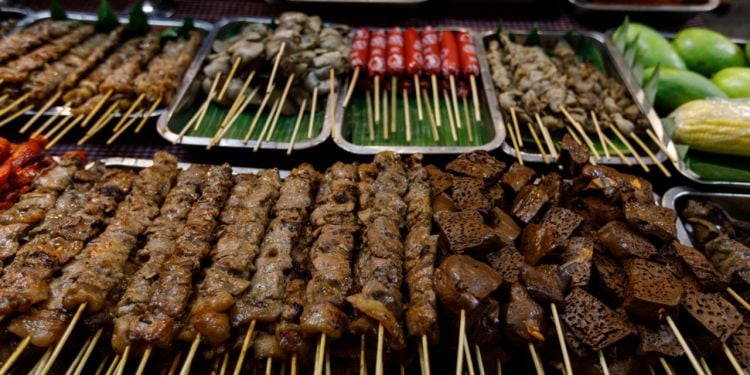The cuisine and food scene in Manila

The food of Manila reflects an evolution over many centuries, starting from its Austronesian origins and ending with a mixed cuisine of Chinese, Spanish and American influence. Filipino cuisine is a composite of more than a hundred distinct ethnolinguistic groups found throughout the Philippine archipelago, adapted to indigenous ingredients and the local palate.
Most Filipino dishes are predominantly meat-based, including beef, chicken, and pork, and occasionally goat. Offal is also commonly eaten by Filipinos and forms the main ingredient of dishes like dinuguan, sisig, and street food like adidas and isaw.
Popular dishes in Manila
Manila has a ton of great food to offer, and below are some of the must-try dishes to look out for.
Adobo in Manila
Adobo is dubbed the unofficial national dish of the Philippines, and you will see this dish on pretty much every Filipino menu. The dish is made by simmering meat in a marinade of soy sauce, vinegar and garlic. The most popular versions of adobo are those made with chicken, pork, or seafood. The result of the combination of vinegar and soy sauce in this dish is a delicious and comforting delicacy best eaten with steamed white rice. It is not popular solely for its simplicity and ease of preparation but also for its ability to be stored for days without spoiling, and it even boasts an enhancement of flavor with a day or two of storage. You will find adobo and other adobo variations offered in places ranging from carinderias (open-air neighborhood eateries) to upscale restaurants serving Filipino cuisine, like Mesa or Gerry's Grill, each with multiple locations around the city.
Lechon (Pork)
Filipino celebrations like birthdays, fiestas, or New Year wouldn't be complete without Lechon as the centerpiece of the dinner table. It is a whole roasted pig characterized by a crisp outer skin and a moist, juicy interior with a flavourful taste from the blend of spices. It is best eaten with sarsa or liver sauce.
Kare-Kare
Kare-Kare is a classic but unique Filipino dish consisting of oxtail, tripe, eggplants, and beans. It's a peanut-based stew rich with flavor from peanut butter, onions, garlic, and annatto and thickened with plain ground rice. This dish is typically served in a clay pot — called a palayok — with a side of bagoong or fermented shrimp paste. It takes a fair amount of time to prepare this dish; hence, the homemade Kare-Kare is served only on special occasions such as Christmas or birthdays. Max's Restaurant (with multiple branches around the city) serves authentic Kare-Kare, which is a must-try.
Pandesal
A traditional Filipino breakfast might include pandesal (small bread rolls) either eaten directly or dunked in hot coffee. It translates from the Spanish pan de sal, which literally means bread of salt. Contrary to its Spanish name origins, pandesal tastes more subtly sweet than salty, as very little salt is used in baking it. It can be eaten with spreads like cheese, butter, coconut jam, or peanut butter. Best served piping hot, these bread rolls are slightly crispy on the outside and are usually baked covered in breadcrumbs. This is legitimate Filipino fare and can be bought from any neighborhood bakery, usually early in the morning (8-10 am). You can also find it in chains like Pan de Manila.
Halo-halo in Manila
You will know it's officially summer when Manila's streets get dotted with makeshift counters – usually staffed by moms or kids – serving a shaved ice dessert with combinations of ingredients such as sweet beans, sugar palm fruit (kaong), jackfruit (langka), nata de coco, sweetened banana, coconut jellies, and evaporated milk. It is usually topped with ube (purple yam), leche flan, or ice cream for an extra treat. Few Filipino desserts are as popular as halo-halo, which literally means “mix-mix,” pertaining to its diverse mix of ingredients. Almost all Filipino restaurants serving this sweet cold treat offer their own variations, but Razon's of Guagua's halo-halo gets a lot of attention because of its pure goodness in simplicity– with only four ingredients, bananas, macapuno, milk and leche flan. You can also try halo-halo at Mang Inasal, a restaurant mainly known for its roasted chicken but serving this great treat as well.
Street food in Manila
Notable Filipino street food includes Kwek-Kwek — deep-fried hard-boiled quail eggs dipped in a bright orange batter — and isaw — grilled pig and chicken intestines dipped in vinegar. If adobo is the most famous Filipino dish, then balut has got to be the most famous (or infamous) street food. Balut is a developing duck embryo that is boiled and eaten in its shell. It is tastier than it seems and actually delicious with salt and chili. Be careful when eating balut after consuming alcohol as it is high in cholesterol.
It's a snack that is readily available everywhere and quite common to eat in the evening. There are food stalls and street food carts dotted all over Manila where you can find these street food items. You can also get to try these authentic Filipino items while walking around any local market.
Jollibee in Manila
No one leaves the Philippines without sampling the famous chicken joy of Jollibee. It is the most famous Filipino-owned fast-food chain in the country. Jollibee is a Philippine institution! They offer fried chicken, spaghetti, and yummy burgers that all Filipinos love. You can enjoy this favorite fast food with more or less 150 pesos in your pocket. It is tasty and a hit with Westerners.








